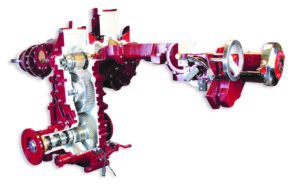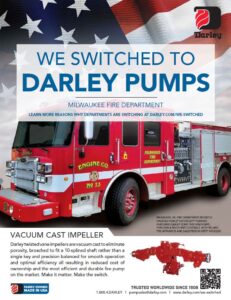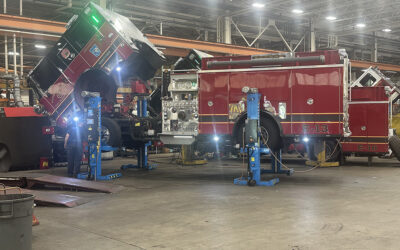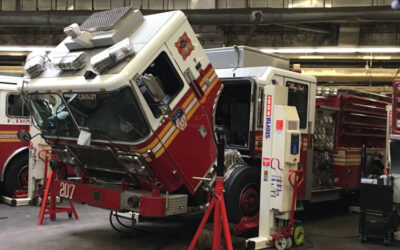
W.S. Darley & Company’s LDMX-MT pump is a combination of its LDM pump and its MegaTrans™ (MT) transmission. (Photos courtesy of W.S. Darley & Company.)
By Jason S. Darley
The Darley LDMX-MT is making waves from the Milwaukee (WI) Fire Department to Baltimore County, Maryland, and now on the West Coast. The LDM is currently being installed at one of our OEM partner facilities for the California Office of Emergency Services (OES), which specified it in its latest Type 1 pumpers.
Why are these major departments switching to the LDMX-MT?
To understand the LDMX-MT, let’s unpack the naming designation. The LDMX-MT is a combination of Darley’s LDM pump and the MegaTrans™ (MT) transmission. The “X” in LDMX-MT simply means we do not supply the typical discharge plumbing and valves that would be found on our standard LDM. The removal allows for better packaging and a weight reduction through the use of stainless-steel manifolds developed by our OEM customers.

Milwaukee (WI) Fire Department switched to 1,500-gallons-per-minute (gpm) Darley LDMX-MT pumps on its new Pierce Manufacturing Enforcer™ pumpers.
In comparing the LDMX and the LDMX-MT drawings, you may ask, “Why the MegaTrans?” given it is overall a larger transmission than Darley’s MagnaTrans™. The answer is that this transmission allows for a deeper driveline drop, which allows OEMs to locate the pump in the same driveline configurations as competitive products in the marketplace. The MegaTrans was designed to reduce engineering requirements and time, which allows the LDMX-MT, or several other Darley pumps coupled to this transmission, to be offered to the customer without the need to evaluate in detail the full drive train layout prior to the offering.
Historically, what our customers have always called “one tough transmission” is now actually two options. The standard MagnaTrans, has been the highest-rated in the industry at 19,230-foot pounds (ft. lbs.) of torque. The MegaTrans is also rated at 19,230 -ft. lbs. of torque throughput, giving Darley two transmissions that can boast the highest torque rating in the industry.
Related Articles:
Darley 1.5AGE24K a Wildland Workhorse
Darley EM Pump Continues to Hold Its Own in Major Metro Fire Departments
Darley PSM Pump Surging in Popularity
As always with the LDM pump, although only rated and advertised to 1,750 gallons per minute (gpm), it flows well over 2,000gpm at 150 pounds per square inch (psi) in max flow testing. This reserve capacity eliminates the common practice of a department paying more for a higher-rated pump, say 2,000gpm, and then “de-rating” the pump to lower flow rates in an effort to ensure the pump passes its annual NFPA (National Fire Protection Association) service tests throughout the life of the apparatus. We do that for customers with the reserve capacity standards we hold ourselves to on our ratings at Darley.
For more information on the LDMX-MT, to discuss Darley pump options with a member of our regional team, to schedule a tour, or for any other opportunities for Darley to serve, feel free to reach out to me at JasonDarley@Darley.com or on my cell phone at (715) 456-9390.
Jason S. Darley is North American sales manager for W.S. Darley & Company.






